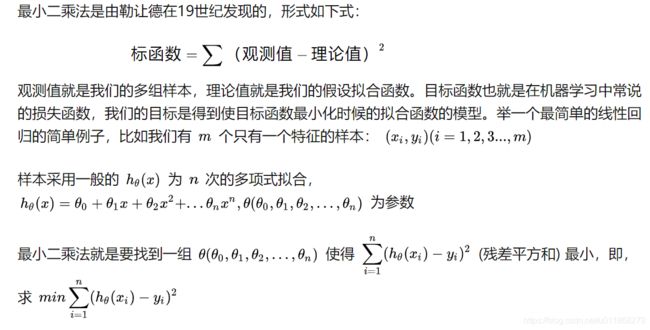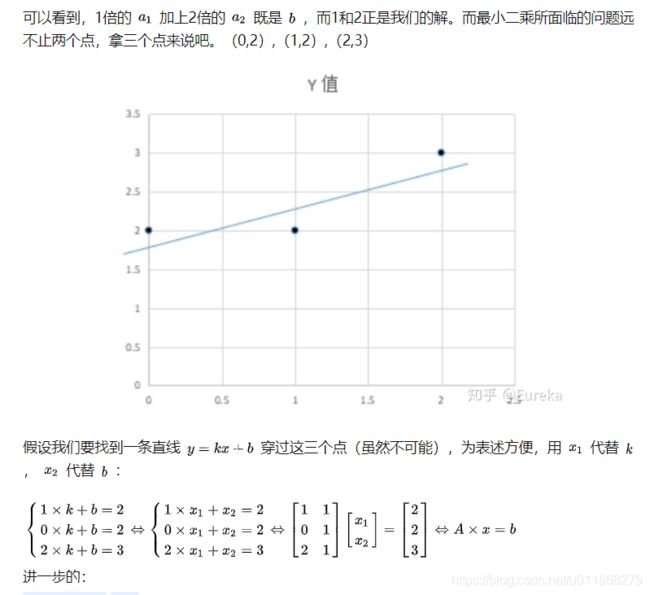关于最小二乘法详解
最小二乘法的原理与要解决的问题
最小二乘法的矩阵法解法
最小二乘法的几何解释
最小二乘法的局限性和适用场景
最小二乘法的python实战
import numpy as np
import scipy as sp
from scipy.optimize import leastsq
import matplotlib.pyplot as plt
%matplotlib inline
# 目标函数
def real_func(x):
return np.sin(2*np.pi*x)
#多项式
#ps: numpy.polyld([1,2,3]) 生成 $1x^2+2x^1+3x^0$*
def fit_func(p, x):
f = np.poly1d(p)
return f(x)
# 残差
def residuals_func(p, x, y):
ret = fit_func(p, x) - y
return ret
# 十个点
x = np.linspace(0, 1, 10)
x_points = np.linspace(0, 1, 1000)
# 加上正态分布噪音的目标函数的值
y_ = real_func(x)
y = [np.random.normal(0, 0.1)+y1 for y1 in y_]
def fitting(M=0):
"""
n 为 多项式的次数
"""
# 随机初始化多项式参数
p_init = np.random.rand(M+1)
# 最小二乘法
p_lsq = leastsq(residuals_func, p_init, args=(x, y))
print('Fitting Parameters:', p_lsq[0])
# 可视化
plt.plot(x_points, real_func(x_points), label='real')
plt.plot(x_points, fit_func(p_lsq[0], x_points), label='fitted curve')
plt.plot(x, y, 'bo', label='noise')
plt.legend()
return p_lsq
# M=0
p_lsq_0 = fitting(M=0)
Fitting Parameters: [0.01914362]
# M=1
p_lsq_1 = fitting(M=1)
Fitting Parameters: [-1.44035975 0.73932349]
# M=3
p_lsq_3 = fitting(M=3)
Fitting Parameters: [ 23.32730356 -34.84982011 11.69490865 -0.04614352]
# M=9
p_lsq_9 = fitting(M=9)
Fitting Parameters: [-7.72885226e+03 3.20354672e+04 -5.42647096e+04 4.81881349e+04 -2.38777532e+04 6.47385739e+03 -8.52906000e+02 1.74436725e+01 9.47089325e+00 1.35011754e-02]
当M=9时,多项式曲线通过了每个数据点,但是造成了过拟合
正则化
结果显示过拟合, 引入正则化项(regularizer),降低过拟合
[公式]
回归问题中,损失函数是平方损失,正则化可以是参数向量的L2范数,也可以是L1范数。
L1: regularization*abs(p) L2: 0.5 * regularization * np.square(p)
regularization = 0.0001
def residuals_func_regularization(p, x, y):
ret = fit_func(p, x) - y
ret = np.append(ret, np.sqrt(0.5*regularization*np.square(p))) # L2范数作为正则化项
return ret
# 最小二乘法,加正则化项
p_init = np.random.rand(9+1)
p_lsq_regularization = leastsq(residuals_func_regularization, p_init, args=(x, y))
plt.plot(x_points, real_func(x_points), label='real')
plt.plot(x_points, fit_func(p_lsq_9[0], x_points), label='fitted curve')
plt.plot(x_points, fit_func(p_lsq_regularization[0], x_points), label='regularization')
plt.plot(x, y, 'bo', label='noise')
plt.legend()













